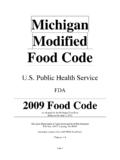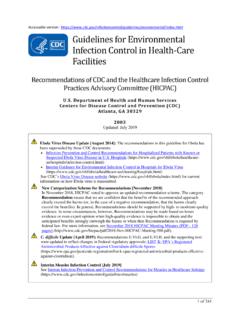Transcription of An Introduction to Measles - Centers for Disease Control ...
1 An Introduction to Measles Last updated 04/30/2019 1. What is Measles Measles is a respiratory Disease caused by a virus. Measles is one of the most contagious diseases. Measles has been around for more than 1,000 years. Millions of people worldwide get Measles each year, and thousands die from the Disease . 2. Slide 2 Notes In the 9th century, a Persian doctor published one of the first written accounts of Measles Disease . In 1963, Measles vaccine was licensed in the United States, and in 1968, Measles vaccine began to be distributed. Measles was declared eliminated from the United States in 2000. Elimination means there was no continuous Disease transmission for more than 12 months. This was possible thanks to a highly effective vaccination program and better Measles Control in the Americas region. 3. Measles Symptoms High fever Cough Runny nose Red, watery eyes Tiny white spots inside the mouth Rash from head to toe Three to five days after symptoms begin, a rash breaks out.
2 When the rash appears, a person's fever may spike to more than 104 Fahrenheit. After a few days, the fever subsides and the rash fades. 4. Slide 4 Notes The symptoms of Measles generally appear about seven to 14 days after a person is infected. Measles typically begins with High fever, which may spike to more than 104 degrees Fahrenheit Cough Runny nose (coryza). Red, watery eyes (conjunctivitis ). Two or three days after symptoms begin, tiny white spots (Koplik spots) may appear inside the mouth. Three to five days after symptoms begin, a rash breaks out. It usually begins as flat red spots that appear on the face at the hairline and spread downward to the neck, trunk, arms, legs, and feet. Small raised bumps may also appear on top of the flat red spots. The spots may become joined together as they spread from the head to the rest of the body.
3 When the rash appears, a person's fever may spike to more than 104 Fahrenheit. After a few days, the fever subsides and the rash fades. 5. Photos of People with Measles Koplik spots inside the mouth Measles skin rash 6. Slide 6 Notes This slide shows photos of children with Measles rash on their bodies and Koplik spots inside the mouth. 7. Measles Can Be Serious Children <5 years old and adults >20 years old more likely to suffer from Measles complications. Common complications Ear infections Diarrhea Severe complications Pneumonia Encephalitis Long-term complications Subacute sclerosingpanencephalitis (SSPE. ). Can cause death 8. Slide 8 Notes About 1 in 4 people who get Measles will be hospitalized. Common complications Ear infections Diarrhea Severe complications Pneumonia (infection of the lungs). Encephalitis (swelling of the brain) - 1 out of every 1,000 people with Measles Long-term complications Subacute sclerosingpanencephalitis (SSPE)- a very rare, but fatal Disease of the central nervous system that results from a Measles virus infection acquired earlier in life.
4 Can cause death 1 or 2 out of 1,000 people with Measles 9. Measles Spreads Easily Measles is so contagious that if one person has it, up to 90%. of the people close to that person who are not protected will also become infected. Measles spreads when infected people cough or sneeze. Infected people can spread Measles 4 days before they get the rash through 4 days after it appears. 10. Slide 10 Notes Measles is so contagious that if one person has it, up to 90%. of the people close to that person who are not immune will also become infected. Measles virus lives in the nose and throat of an infected person. o If other people breathe the contaminated air or touch a contaminated surface, then touch their eyes, nose, or mouth, they can become infected. Infected people can spread Measles 4 days before they get the rash through 4 days after it appears.
5 11. Measles is Just a Plane Ride Away Measles is still common in many other countries. Unvaccinated travelers continue to get Measles in other countries and bring it into the United States. Then they can spread it to others. Anyone who is not protected against Measles is at risk of getting the Disease . 12. Slide 12 Notes Every year, Measles is brought into the United States by unvaccinated travelers (mostly Americans) who get Measles while they are in other countries. They can spread Measles to other people who are not protected against Measles , which sometimes leads to outbreaks. This can occur in communities with unvaccinated people. Since 2000, when Measles was declared eliminated from the , the annual number of people reported to have Measles ranged from a low of 37 people in 2004 to a high of 667. people in 2014.
6 The 2019 case count exceeded 2014 levels as of April 26, 2019, and continues to climb. 13. Vaccination is the Best Protection Against Measles Two doses of MMR ( Measles -mumps-rubella) vaccine are 97% effective at protecting against Measles . MMR vaccine protects you and people who are unable to be vaccinated because they are too young or have weakened immune systems. 14. Slide 14 Notes One dose of MMR vaccine is 93% effective at protecting against Measles . In the United States, widespread use of Measles vaccine has led to a greater than 99% reduction in Measles cases compared with the pre-vaccine era. 15. Who Should Get Vaccinated Children First dose at 12 through 15 months of age Second dose at 4 through 6 years ofage Students at post-high school educational institutions with no evidence of immunity*. Two doses separated by at least 28days Adults born after 1957 with no evidence of immunity*.
7 At least one dose International travelers with no evidence of immunity*. Infants 6 through 11 months of age: onedose Children 12 months of age andolder (including teenagers and adults): two doses separated by at least 28days Healthcare workers with no evidence of immunity*. Two doses separated by at least 28days 16. *Acceptable presumptive evidence of immunity against Measles includes at least one of the following: written documentation of adequate vaccination, laboratory evidence of immunity, laboratory confirmation of Measles , or birthbefore 1957. Slide 16 Notes Children o Two doses of MMR vaccine, starting with the first dose at 12 through 15 months of age, and the second dose at 4 through 6 years of age. Students at post-high school educational institutions with no evidence of immunity o Students who do not have evidence of immunity against Measles need two doses of MMR vaccine, separated by at least 28 days.
8 Adults with no evidence of immunity o Adults who do not have evidence of immunity against Measles should get at least one dose of MMR. vaccine. International travelers with no evidence of immunity o Infants 6 through 11 months of age should receive one dose of MMR vaccine. Infants who get one dose of MMR vaccine before their first birthday should get two more doses (one dose at 12 through 15 months of age and another dose at least 28 days later). o Children 12 months of age and older should receive two doses of MMR vaccine, separated by at least 28. days. o Teenagers and adults who do not have evidence of immunity against Measles should get two doses of MMR vaccine separated by at least 28 days. Healthcare workers with no evidence of immunity o Healthcare personnel without evidence of immunity should get two doses of MMR vaccine, separated by at least 28 days.
9 Acceptable presumptive evidence of immunity against Measles includes at least one of the following: written documentation of adequate vaccination, laboratory evidence of immunity, laboratory confirmation of Measles , or birth before 1957. 17. Slide 16 Notes (cont'd). Some people should not get MMR vaccine or should wait. Anyone who has ever had a life-threatening allergic reaction to the antibiotic neomycin, or any other component of MMR vaccine, should not get the vaccine. Tell your doctor if you have any severe allergies. Anyone who had a life-threatening allergic reaction to a previous dose of MMR or MMRV vaccine should not get another dose. Some people who are sick at the time the shot is scheduled may be advised to wait until they recover before getting MMR vaccine. Pregnant women should not get MMR vaccine.
10 Pregnant women who need the vaccine should wait until after giving birth. Women should avoid getting pregnant for 4 weeks after vaccination with MMR vaccine. Tell your doctor if the person getting the vaccine: Has HIV/AIDS, or another Disease that affects the immune system Is being treated with drugs that affect the immune system, such as steroids Has any kind of cancer Is being treated for cancer with radiation or drugs Has ever had a low platelet count (a blood disorder). Has gotten another vaccine within the past 4 weeks Has recently had a transfusion or received other blood products Any of these might be a reason to not get the vaccine, or delay vaccination until later. 18. Measles Resources from CDC. General information: Measles Measles resources: Feature on Measlesvaccination website: Materials for travelers Traveler'shealth Measles page: 19.












